Related Research Articles
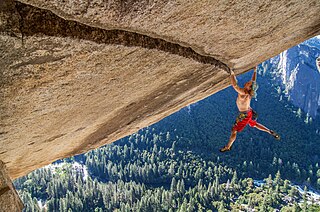
Climbing is the activity of using one's hands, feet, or other parts of the body to ascend a steep topographical object that can range from the world's tallest mountains to small boulders. Climbing is done for locomotion, sporting recreation, for competition, and is also done in trades that rely on ascension, such as rescue and military operations. Climbing is done indoors and outdoors, on natural surfaces, and on artificial surfaces

Underground hard-rock mining refers to various underground mining techniques used to excavate "hard" minerals, usually those containing metals, such as ore containing gold, silver, iron, copper, zinc, nickel, tin, and lead. It also involves the same techniques used to excavate ores of gems, such as diamonds and rubies. Soft-rock mining refers to the excavation of softer minerals, such as salt, coal, and oil sands.
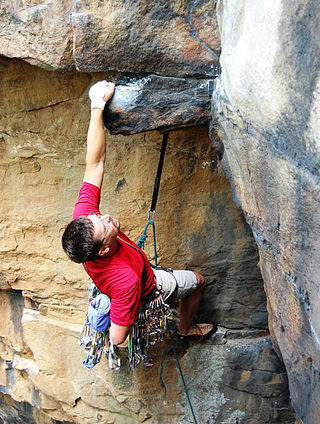
Traditional climbing is a type of free climbing in rock climbing where the lead climber places the protection equipment while ascending the route; when the lead climber has completed the route, the second climber then removes the protection equipment as they climb the route. Traditional climbing differs from sport climbing where the protection equipment is already pre-drilled into the rock in the form of bolts.

A climbing route is a path by which a climber reaches the top of a mountain, or rock/ice-covered obstacle. The details of a climbing route are recorded in a climbing guidebook and/or in an online climbing route database, and will include elements such as the type of climbing route, the difficulty grade of the route–and beta on its crux(es)–and any risk or commitment grade, the length and number of pitches of the route, and the type of climbing equipment needed to complete the route.

Glossary of climbing terms relates to rock climbing, mountaineering, and to ice climbing.

Rock-climbing equipment varies with the type of climbing undertaken. Bouldering needs the least equipment outside of shoes and chalk and optional crash pads. Sport climbing adds ropes, harnesses, belay devices, and quickdraws to clip into pre-drilled bolts. Traditional climbing adds the need for carrying a "rack" of temporary passive and active protection devices. Multi-pitch climbing adds devices to assist in ascending and descending fixed ropes. And finally aid climbing uses unique equipment.
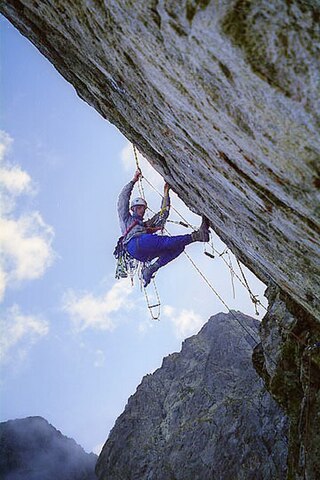
Aid climbing is a form of rock climbing that uses mechanical devices and equipment, such as aiders, for upward momentum. Aid climbing is the opposite of free climbing, which only uses mechanical equipment for protection, but not to assist in upward momentum. "Traditional aid climbing" involves hammering in permanently fixed pitons and bolts, into which aiders are clipped, whereas "clean aid climbing" avoids hammering, and only uses removable placements.

Sport climbing is a type of free climbing in rock climbing where the lead climber clips into pre-drilled permanent bolts for their protection while ascending a route. Sport climbing differs from the riskier traditional climbing where the lead climber has to insert temporary protection equipment while ascending.

Belaying is a variety of techniques climbers use to create friction within a climbing system, particularly on a climbing rope, so that a falling climber does not fall very far. A climbing partner typically applies tension at the other end of the rope whenever the climber is not moving, and removes the tension from the rope whenever the climber needs more rope to continue climbing.
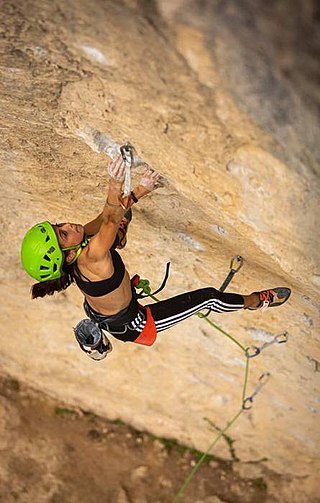
Lead climbing is a technique in rock climbing where the lead climber clips their rope to the climbing protection as they ascend the climbing route, while their second remains at the base of the route belaying the rope to protect the lead climber in the event that they fall. The term is used to distinguish between the two roles, and the greater effort and increased risk, of the role of the lead climber.

In rock climbing, a bolt is a permanent anchor fixed into a hole drilled in the rock as a form of climbing protection. Most bolts are either self-anchoring expansion bolts or fixed in place with liquid resin. Climbing routes that are bolted as known as sport climbs, and those that do not use bolts, are known as traditional climbs.
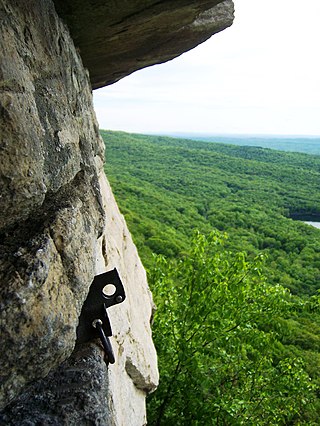
Clean climbing is rock climbing techniques and equipment which climbers use in order to avoid damage to the rock. These techniques date at least in part from the 1920s and earlier in England, but the term itself may have emerged in about 1970 during the widespread and rapid adoption in the United States and Canada of nuts, and the very similar but often larger hexes, in preference to pitons, which damage rock and are more difficult and time-consuming to install. Pitons were thus eliminated in North America as a primary means of climbing protection in a period of less than three years.

A piton in big wall climbing and in aid climbing is a metal spike that is driven into a crack or seam in the climbing surface using a climbing hammer, and which acts as an anchor for protecting the climber against the consequences of falling or to assist progress in aid climbing. Pitons are equipped with an eye hole or a ring to which a carabiner is attached; the carabiner can then be directly or indirectly connected to a climbing rope.

Rock climbing is a sport in which participants climb up, across, or down natural rock formations or indoor climbing walls. The goal is to reach the summit of a formation or the endpoint of a usually pre-defined route without falling. Rock climbing is a physically and mentally demanding sport, one that often tests a climber's strength, endurance, agility and balance along with mental control. Knowledge of proper climbing techniques and the use of specialized climbing equipment is crucial for the safe completion of routes.
In rock climbing, an anchor can be any device or method for attaching a climber, a rope, or a load above or onto a climbing surface—typically rock, ice, steep dirt, or a building—either permanently or temporarily. The intention of an anchor is case-specific but is usually for fall protection, primarily fall arrest and fall restraint. Climbing anchors are also used for hoisting, holding static loads, or redirecting a rope.

A wall plug, also known as an anchor (US) or "Rawlplug" (UK), is a fibre or plastic insert used to enable the attachment of a screw in material that is porous or brittle or that would otherwise not support the weight of the object attached with the screw. It is a type of anchor that, for example, allows screws to be fitted into masonry walls. In US English, mentions of drywall anchors are sometimes meant to refer specifically to the type of plastic wall plugs with expandable wings for hollow walls, in contradistinction with mollies and toggle bolts.

The Abalakov thread, also known as a V-thread, A-thread, or 0-thread, is an ice protection technique named after its inventor, Soviet climber Vitaly Abalakov. The Abalakov thread is a common method of protecting oneself while ice climbing because it is easy to create, does not require the sacrifice of expensive gear, and can be very safe when used properly. An Abalakov thread is often used in multi-pitch ice climbing routes. Because of its safety and convenience, the Abalakov thread is considered one of the most significant innovations in ice climbing. It significantly expanded the scope of possible routes and abseiling safety.
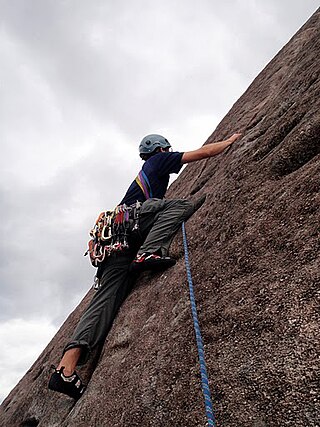
Slab climbing is a type of rock climbing where the rock face is at an angle less steep than vertical. It is characterized by balance- and friction-dependent moves on very small holds. It is often not leadable, or climbable from the ground up, unless it has pre-drilled bolts to protect the climb, making most slab climbs either top rope climbing or sport climbing. Special techniques such as smearing are necessary to climb slab. It is a type of face climbing and is distinctly different from crack climbing. Slab climbing is a relatively new area of climbing, having become more popular in the last 30 years, and some of the highest graded routes are currently being realized.

Sasha DiGiulian is a professional rock climber who specializes in competition climbing, sport climbing and bouldering. She won the gold medal at the 2011 International Federation of Sport Climbing World Championships in Arco, Italy, for Female Overall, placed Silver in Bouldering and Bronze in Duel. Sasha won multi-year PanAmerican championships and is a three-time US National Champion.

Crack climbing is a type of rock climbing in which the climber follows a crack in the rock and uses specialized climbing techniques. The sizes of cracks vary from those that are just barely wide enough for the fingers to fit inside, to those that are so wide that the entire body can fit inside with all limbs outstretched. Many traditional climbing routes follow crack systems, as they provide natural opportunities for placing protective equipment.
References
- http://www.rockandice.com/lates-news/climbtech-rb-anchor-and-perma-draw
- http://www.rockandice.com/lates-news/josh-wharton-the-alpinist
- http://www.upskillclimbinggear.com/products/Removable-Bolt.html
- http://www.dpmclimbing.com/climbing-videos/watch/climbtech-removable-bolts-rock-climbing
- http://www.mountainproject.com/v/removable-bolt-trial-by-fire-by-manufacturer/107502423
- http://www.supertopo.com/climbing/thread.php?topic_id=743502
- http://www.patrollersupply.com/equipment/item_193.asp
- http://www.dpmclimbing.com/articles/view/joe-kinder-bolting-next-generation